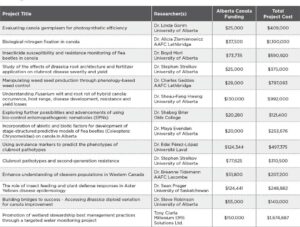Alberta Sustainability Bulletin
Update on agriculture research in Alberta
Over the last year, Alberta Canola invested over $900,000 toward funding 14 new projects representing approximately $7.7 million worth of research. Every $1 of farmer levy invested by Alberta Canola was matched by more than $8 of investment by research partners and funding programs.
A reoccurring theme throughout the bulk of the projects was to reduce a pest’s impact on canola. This objective was explored through many means, including germplasm and genetic evaluation, pest monitoring systems, nematode biocontrol, pest biology, and novel control methods, to name a few.
Although canola hybrid systems can shift attention away from weeds, the rise in herbicide-resistant weeds is concerning and therefore, unique approaches to manage them are necessary. Breanne Tidemann at Agriculture and Agri-Food Canada – Lacombe is characterizing cleaver populations and biotypes in western Canada for their long-term management, while Charles Geddes at Agriculture and Agri-Food Canada – Lethbridge manipulates weed seed production based on the life cycle timing of the weed. Both projects aim attention at further understanding and identifying herbicide-resistant weed biotypes.
Over the past several years, a quarter of Alberta Canola’s research funding dollars have gone towards canola disease research due to newly emerging and challenging diseases like clubroot and fusarium wilt. Stephen Strelkov from the University of Alberta will continue to broaden our knowledge of clubroot disease through pathotype surveillance and observing the disease’s relationship with canola roots and fertilizer application. Additionally, he has teamed up with Edel Pérez López from the University of Laval in Québec, a new researcher to Alberta Canola, to develop a laboratory method to differentiate pathotypes of the clubroot pathogen. Furthermore, fusarium wilt is a canola disease expanding across the Canadian prairies. Sheau-Fang Hwang at the University of Alberta will explore its occurrence, host range, development, cultivar resistance, and yield losses within Alberta.
With an increasing global focus on environmental stewardship and climate change, there’s been a greater need to address the physiology of the canola plant. Linda Gorim at the University of Alberta is evaluating canola germplasm for photosynthetic efficiency, while Alicia Ziemienowicz at Agriculture and Agri-Food Canada – Lethbridge looks at developing canola that can fix its own atmospheric nitrogen.
In addition to agronomic research and genetic development, Alberta Canola has allocated $150,000 over three years to monitor water in wetlands and promote best management practices for their stewardship. The Crop Sector Working Group (CSWG), three major life-science companies; Syngenta, BASF, and Bayer Crop Science – Canada, and the Pest Management Regulatory Agency (PMRA), have all partnered together with additional support from Results Driven Agriculture Research (RDAR) and the Canadian Agricultural Partnership (CAP) to produce a comprehensive and extensive report. This collaboration is necessary to ensure that the environmental stewardship practices are sound, and innovative crop protection tools continue to be available to farmers. Ultimately, the scientific data will identify the effectiveness of wetland management practices in mitigating the movement of crop protection products into wetlands and aquatic ecosystems.






